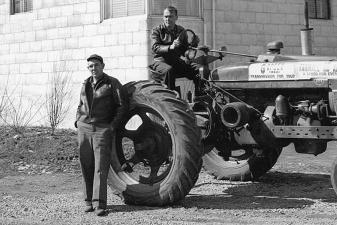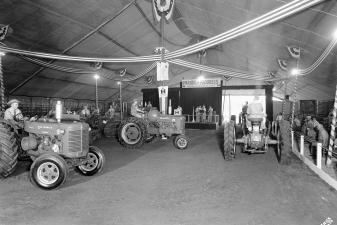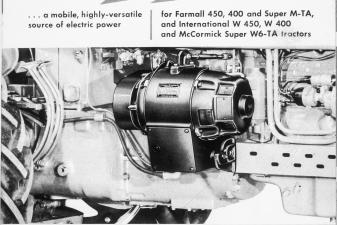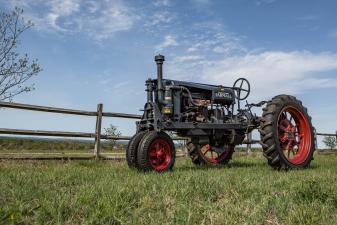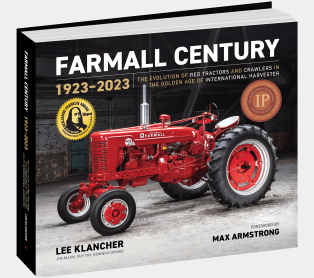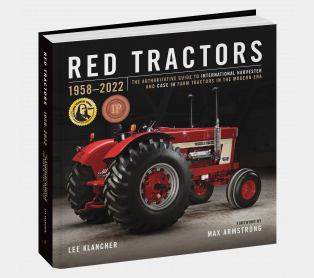How Well Do You Know The First Tractor?

The 100th Anniversary of the revolutionary Farmall tractor is celebrated in Farmall Century: 1923–2023, the authoritative model-by-model history that traces the evolution and design of the most significant farm tractors of the 20th century. Award-winning author Lee Klancher chronicles how and why the Farmall tractor came to exist and how it evolved with his signature blend of compelling stories, engaging text, and spectacular images. Written by contributor Guy Fay, this excerpt details the history behind the first gasoline-powered tractors in the United States . . . which is not the machine you may think it is!
By 1886, the Charter Gas Engine Company was selling gas engines, and it may have been the first company in the United States to build and sell portable gas engines (which were simply engines mounted on wheeled carts, typically pulled by horses). Shortly thereafter, independent of Charter Gas Engine, John Charter and Franz Burger began experimenting with a self-propelled gas engine—a machine then known as a gas traction engine, now known as a tractor. Their work began on behest of another company based in Illinois—Keystone Manufacturing.
Keystone was founded by Thomas A. Galt in 1857 in Sterling, Illinois. After a fire in 1867, the company moved across the Rock River to Rock Falls. Keystone built farm implements, including one of the first husker shredders, a line of corn shellers, as well as tillage and planting implements.
Keystone used “horsepowers” or “horse sweeps,” to power large implements with horses. The horses are hitched to a unit that looks like a merry-go-round. The horses walk in a circle, turning the horse sweep, and the horse sweep transfers power to the implement through a rotating shaft. Similar machines were used by other companies such as J. I. Case to power threshing machines and other equipment.
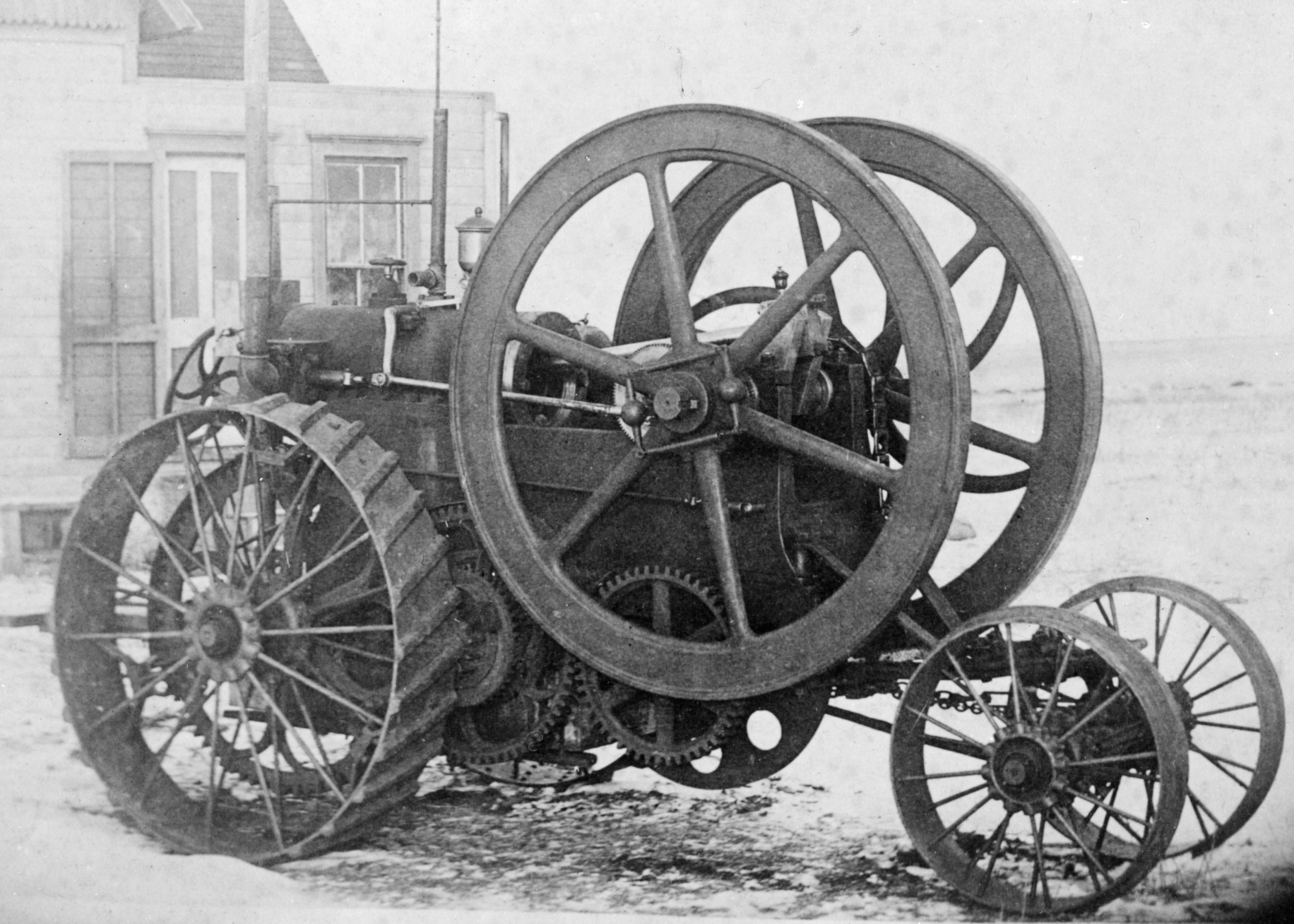
This photo is the only surviving record of what is likely the first version of the tractor that Keystone and Charter were developing, identified by Leo Burger as being worked on by his father, Franz Burger. The tractor may have used a wagon to carry sufficient cooling water; one report has the tractor working with a water tank on a separate wagon for belt work and relying on a small cooling tank for moving between farms. Wisconsin Historical Society / 22881
Unlike the threshing machine companies, the Keystone company did not manufacture portable steam engines that could power even larger machines or steam traction engines that could move the rigs from place to place. Keystone’s advertising portrayed its largest shellers and shredders paired with generic steam engines. Keystone ads showed the smaller machines being pulled from farm to farm by some very hard-working horses.
At some point shortly after the Charter gas engine started selling well, Thomas Galt and John Tracey of Keystone made a deal. They wanted to produce the Charter gas engine for the European market, and they purchased a half interest in the European gas engine patents owned by John Charter. On March 2, 1887, the Sterling Daily Gazette reported John Charter was building an engine specifically for the American Manufacturer’s and Inventors Exhibition in London, with his son scheduled to travel there to run the booth, which was to be manned strictly by Americans.
John Charter also designed and built a gas tractor for Keystone, reportedly for $10,000. Using a 20-horsepower Charter gas engine, the Keystone gasoline traction engine was tested powering a six-hole corn sheller on the farm of Sheldon and Stone. The September 13, 1888, issue of the Sterling Daily Gazette reported it shelled 850 bushels of grain in four hours with seven-and-a-half gallons of gas at ten cents per gallon. Galt and Tracey were reported to be in the process of making “a few slight changes” and getting the machine into production. Author C. H. Wendel identifies this tractor as one of the first gasoline tractors built.
In the mid-1890s, Charter resumed the tractor project. This machine, which was often referred to as the Sterline Tractor, has a rudimentary cooling system, although it may have relied on a separate cooling tank. With the huge belt pulley, this is obviously a low-rpm engine. Sterling Rock Falls Historical Society
The Keystone gas traction engine history more or less ends there. One report said that it didn’t work well while pulling a load on rough ground.9 Franz Burger’s son, Leo, was sent to be an expert on the gas traction engine to try to work out its issues. As an aside, Leo Burger would eventually take a job at IH, where his work as an engineer was critical to creating IH’s new diesel engine in the 1920s.
The Keystone company would continue making a variety of agricultural implements and would be purchased by the International Harvester Company in fall 1904.
As for the tractor, Thomas Galt was reported to still be working on it in 1892, but after that, Keystone faded from the story of the Burger tractor. An 1893 lawsuit seemed to blow up the relationship between John Charter and Charter Gas Engine Company, and this may have caused the withdrawal of Galt and Tracey. Charter Gas Engine Company made a short run of redesigned gasoline traction engines in 1894–1895 and sold them in South Dakota.
A young South Dakota thresherman who started with steam in 1888 purchased either a Charter stationary or portable gas engine to learn the new technology, and following the Keystone/Charter gas traction engine, he decided to build his own. For some reason, possibly due to the issues with the Charter, he would purchase a Van Duzen vertical gas engine to put on his chassis. His name was John Froelich.
With its narrow rear wheels, low horsepower, and rudimentary cooling system, the Charter could move to machinery on good roads and farmyards but had issues in softer or rougher ground. Sterling Rock Falls Historical Society
While the Froelich tractor built in 1892 is widely credited as the first gas traction engine—or tractor, if you will—the Burger tractor predates that machine by four years. Given Froelich’s purchase of a Charter machine, it’s highly likely that the inspiration for his machine came from the Burger tractor.
The first gasoline-powered farm tractor known to exist is the Burger tractor, designed by Franz Burger, financed by John Charter, and first tested in 1888.
For more stories like this one, check out the Related Content and Related Books linked below!


